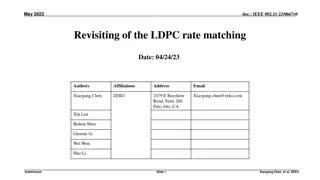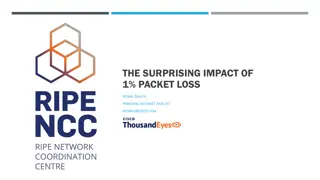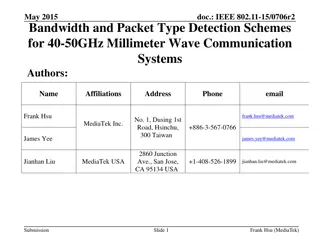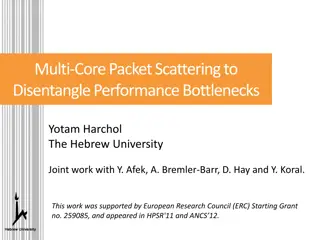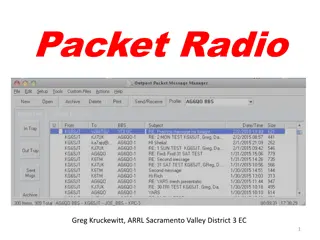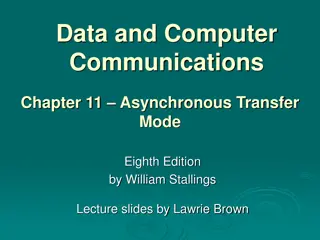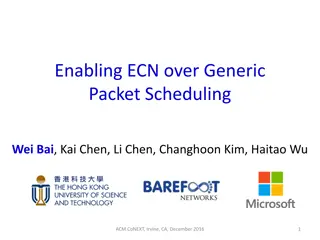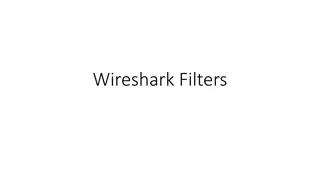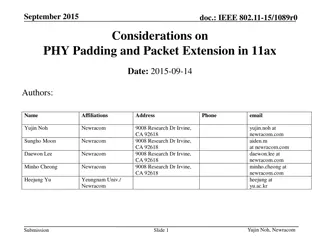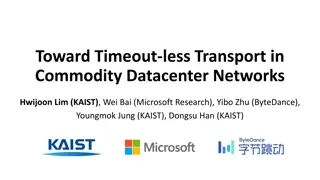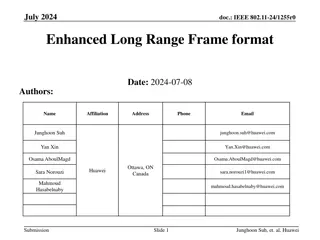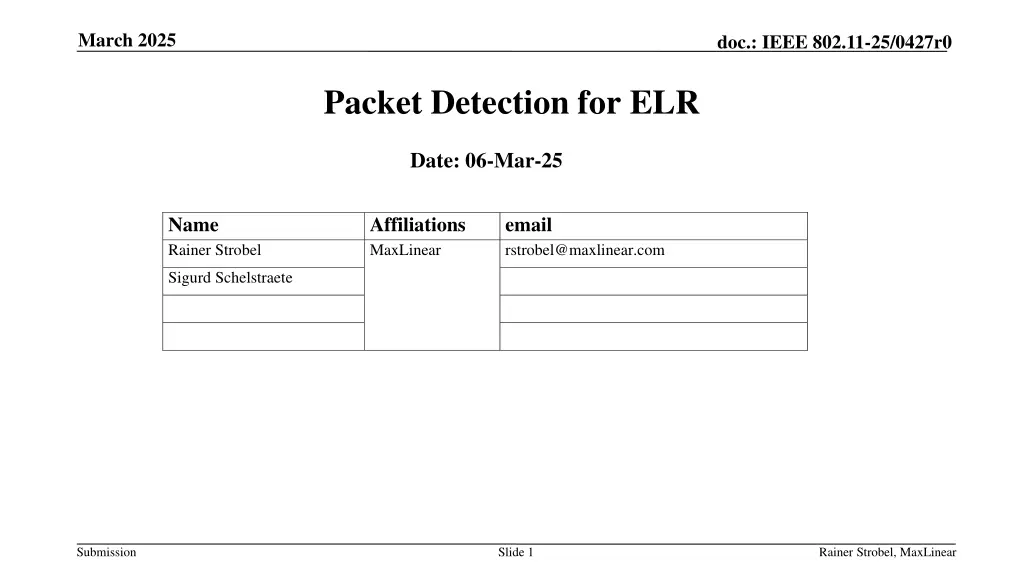
Improving ELR Frame Detection in IEEE 802.11: Cross-Correlation vs. Autocorrelation
Enhance your understanding of the IEEE 802.11 standard by exploring advancements in Extended Long Range (ELR) packet detection. Delve into the comparison between cross-correlation and autocorrelation detection methods, addressing clock synchronization challenges and pre-correction requirements for ELR frames. Discover the mathematical foundations of detection techniques and the significance of Peak-to-Average Power Ratio (PAPR) in signal detection. Gain insights into threshold selection for effective ELR packet detection.
Uploaded on | 3 Views
Download Presentation

Please find below an Image/Link to download the presentation.
The content on the website is provided AS IS for your information and personal use only. It may not be sold, licensed, or shared on other websites without obtaining consent from the author. If you encounter any issues during the download, it is possible that the publisher has removed the file from their server.
You are allowed to download the files provided on this website for personal or commercial use, subject to the condition that they are used lawfully. All files are the property of their respective owners.
The content on the website is provided AS IS for your information and personal use only. It may not be sold, licensed, or shared on other websites without obtaining consent from the author.
E N D
Presentation Transcript
March 2025 doc.: IEEE 802.11-25/0427r0 Packet Detection for ELR Date: 06-Mar-25 Name Rainer Strobel Affiliations MaxLinear email rstrobel@maxlinear.com Sigurd Schelstraete Submission Slide 1 Rainer Strobel, MaxLinear
March 2025 doc.: IEEE 802.11-25/0427r0 Introduction Detection Improvements for ELR Cross-correlation (CC) detection has been proposed [1] to improve detection of ELR frames in low SNR Otherwise range extension may be limited by L-STF detection, despite other ELR improvements in the PPDU format In contrast to autocorrelation (AC) detection, which is widely used now, CC requires a better clock synchronization between transmitter and receiver This contribution Compares autocorrelation vs. cross-correlation detection for different CFO offsets Points out the need to have pre-correction requirements for all ELR PPDUs Provides additional context for CID 357 [2] CID Clause Page Comment Precorrection requirements for ELR PPDUs are only specified for PPDUs sent as immediate responses to an AP PPDU. What requirements apply to other ELR PPDUs? Without the proper precompensation, the extended range property may be lost. Proposed Change Consider requirements for ELR PPDUs not sent as immediate responses to an AP PPDU Will bring submission with further details. 357 38.3.20.2 207.3 Submission Slide 2 Rainer Strobel, MaxLinear
March 2025 doc.: IEEE 802.11-25/0427r0 Mathematics of Detection Autocorrelation detection Receive signal vector ? = [?1, , ??], e.g. ? = 160 samples for 20MHz bandwidth/8 s length. Auto-correlation: ?A?= ? ? = , ?=1 ???? 1 (??= 0 for ? < 1 or ? > ?), ?A? 2? 1 Cross-correlation detection Cross-correlation: ?X?= ? ?ref, ?XC 2? 1 ?ref ?is the known transmit signal PAPR (Peak-to-average power ratio) ? ? ? ???? , ?=1 ?? 1?? , , ?=1 max?=1, ,? 1,?+1, ,2? 1?AC,t max?=1, ,2? 1?XC,t 2, ????AC= ????XC= 2 1 1 2? ?=1, ,? 1,?+1, ,2? ?AC,t 2? ?=1, ,2? ?XC,t Submission Slide 3 Rainer Strobel, MaxLinear
March 2025 doc.: IEEE 802.11-25/0427r0 Example Signals Autocorrelation detection Cross-correlation detection In the ACF, the center value is excluded (as it is always a peak), no frequency offset Submission Slide 4 Rainer Strobel, MaxLinear
March 2025 doc.: IEEE 802.11-25/0427r0 Mathematics of Detection (2) PAPR can be a good measure for signal detection In absence of signal PAPR will be low (top figure) With signal present, PAPR will be high 15.5dB (with signal) vs. 8.5dB PAPR (without signal) in the example figures PAPR decreases as noise, CFO, become stronger Choosing a threshold for PAPR establishes a detect/no-detect criterion See next slides for details Submission Slide 5 Rainer Strobel, MaxLinear
March 2025 doc.: IEEE 802.11-25/0427r0 Threshold Selection Role of the Detection Threshold The threshold for determining a correct detection is subject to the trade-off between false alarms (false positives) and missed detections (false negatives) False alarms cause unnecessary operations at the receiver Missed detections cause a packet loss Threshold Selection From a given false-alarm requirement (e.g., one false- alarm per second), the PAPR threshold can be derived The threshold also depends on the number of antennas 1 antenna 2 antenna 4 antenna Autocorrelation Crosscorrelation 10.9 dB 9.8 dB 9.1 dB 12.2 dB 10.5 dB 9.4 dB Submission Slide 6 Rainer Strobel, MaxLinear
March 2025 doc.: IEEE 802.11-25/0427r0 Mis-Detection Probability (AWGN) Once Threshold is established, the probability of false negatives (misdetection) can be evaluated Conditions (AWGN) No channel, 1 antenna Detection TH = 10.9dB (acorr)/12.2dB (xcorr) i.e., 1 false alarm per second (see slide 6) 5.25GHz channel Observations With less than 5ppm CFO, 3dB improved sensitivity of cross-correlation vs. Autocorrleation is achieved With autocorrelation and cross-correlation, the miss-detection probability is sufficiently low to avoid a substantial increase of the packet error rate Submission Slide 7 Rainer Strobel, MaxLinear
March 2025 doc.: IEEE 802.11-25/0427r0 Mis-Detection Probability (B LOS channel) Conditions B LOS channel, 2 antennas Detection TH = 9.8dB (acorr)/10.5dB (xcorr) i.e., 1 false alarm per second 5.25GHz channel Observation Cross-correlation still achieves ~3dB better sensitivity, but a higher SNR is required for the same miss-detect probability (compared to AWGN) Submission Slide 8 Rainer Strobel, MaxLinear
March 2025 doc.: IEEE 802.11-25/0427r0 Mis-Detection Probability (D NLOS channel) Conditions D NLOS channel, 2 antennas Detection TH = 9.8dB (acorr)/10.5dB (xcorr) i.e., 1 false alarm per second 5.25GHz channel Observation With the D NLOS channel, the performance of cross- correlation detection is degraded Even at higher SNR, there are mis-detects Submission Slide 9 Rainer Strobel, MaxLinear
March 2025 doc.: IEEE 802.11-25/0427r0 PAPR as function of CFO (AWGN) Autocorrelation detection Cross-correlation detection Conditions: 5.25GHz AWGN (no channel) 1 antenna 20MHz bandwidth 8 s LSTF PAPR/dB PAPR/dB While the auto-correlation PAPR doesn t change with the clock offset, cross- correlation PAPR is lowered significantly with increasing clock offset Submission Slide 10 Rainer Strobel, MaxLinear
March 2025 doc.: IEEE 802.11-25/0427r0 PAPR as function of CFO (Channel D) Autocorrelation detection Cross-correlation detection Conditions: 5.25GHz D NLOS channel 2 rx antennas 20MHz bandwidth 8 s LSTF PAPR/dB PAPR/dB The channel impulse response lowers the PAPR and thus, the detection capabilities. Cross-corrleation is more sensitive than autocorrelation Submission Slide 11 Rainer Strobel, MaxLinear
March 2025 doc.: IEEE 802.11-25/0427r0 ELR PPDU pre-compensation Current CFO pre-compensation requirement for ELR PPDUs is 15 kHz (See 38.3.20.2) I.e., 6.25 ppm at 2.4 GHz, 2.7 ppm at 5.5 GHz Both these values correspond to regions where CC outperforms AC (see previous slides) Per 802.11bn D0.1, pre-compensation is only required for ELR PPDU carrying immediate response frame in response to a preceding soliciting frame Degradation of CFO pre-compensation over time may result in CC losing its advantage Submission Slide 12 Rainer Strobel, MaxLinear
March 2025 doc.: IEEE 802.11-25/0427r0 Conclusions Clock Synchronization Requirement Cross-correlation detection only gives a benefit with sufficiently low CFO Multiple antennas help improve detection 802.11bn D0.1 only imposes a precompensation requirements for UL packets sent as responses the AP packets This is not sufficient for general operation If some CFO precompensation is not ensured, the detection sensitivity of CC will decrease and extended-range property of ELR will be lost due to detection errors Receiver complexity and Power Consumption Without guaranteed precompensation, the receiver can not rely on CC exclusively Sophisticated detection schemes (e.g., a combination of cross-correlation and autocorrelation), may have a significant impact on the APs power consumption, as this is the hardware component which remains active all time, even without traffic Submission Slide 13 Rainer Strobel, MaxLinear
March 2025 doc.: IEEE 802.11-25/0427r0 References [1] Wook Bong Lee et.al., An ELR PPDU Follow-Up IEEE 802.11-24/1573r0, September 2024 [2] IEEE 802.11bn CC50 comments on D0.1 , IEEE 802.11-25/0296r0 Submission Slide 14 Rainer Strobel, MaxLinear

